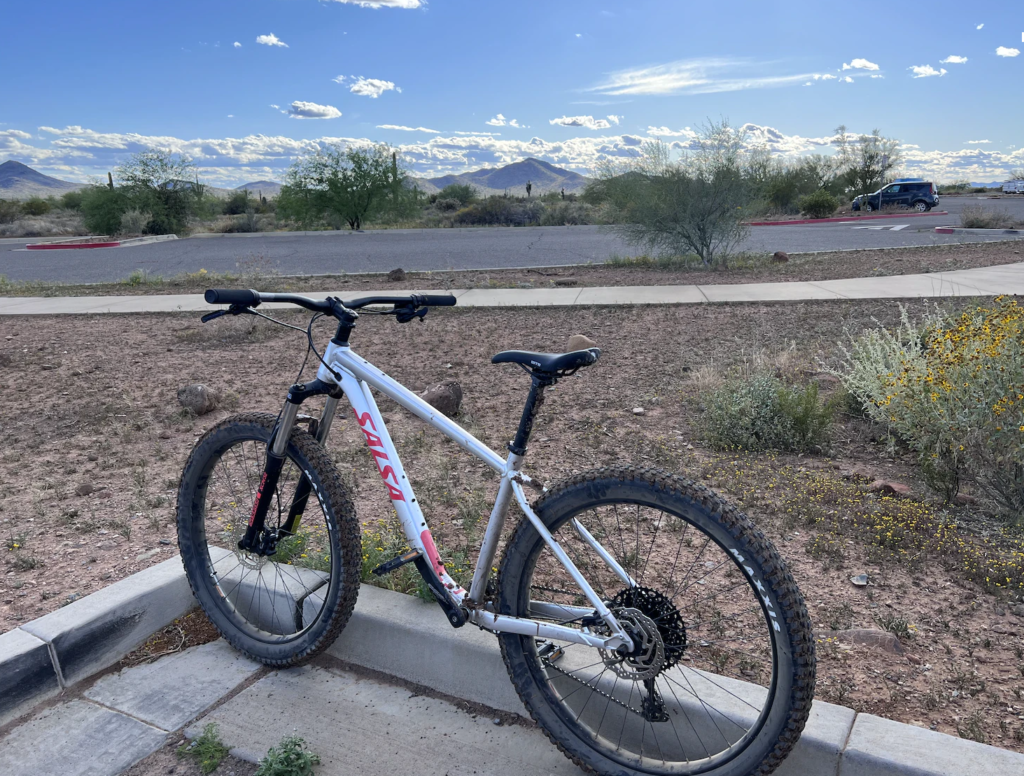Mountain Biking For Runners

Mountain biking for runners? Yes, mountain biking might not be your first choice as a cross-training possibility. It’s expensive, time-consuming, and can be downright scary. But, it can also offer you a new challenge and help with your running. You might already be doing or at least thinking about road biking. However, there is a big difference between mountain biking and road biking. For one thing, you can’t even use the same equipment!
Runners and triathletes are very familiar with road bikes. What are the differences between road bikes and mountain bikes?
- Mountain bikes have fatter tires for more rugged terrain. This makes the tires and bikes more durable.
- You ride in a more upright position. This gives you more stability during your ride and, as a bonus, allows you to better enjoy your view of the nature in which you are riding.
- Mountain bikes absorb more shock, giving you a more comfortable ride on the trails!
As a runner, you know there are several types of running…marathoning, half marathoning, trail running, cross-country running, color runs, fun runs, and so much more. The beauty of running is that you can train for several different kinds of running with only a few varying aspects in your training. After all, running is running. Mountain biking is similar, in that there are several different types of mountain biking…cross-country biking, enduro biking, trail biking, single-speed biking, downhill biking, and even freeride biking.
What are the Benefits of Mountain Biking for Runners?
Builds Muscular Strength:
Mountain biking builds muscular strength in areas often weak and under-developed in runners, including the glutes and core. We know that a strong core improves running stability and control. Plus, strong glutes are essential to running downhill.
But the muscular strength associated with mountain biking doesn’t stop with glutes and your core. Mountain biking is a full-body workout. In addition to working the lower body, your upper body also gets a good workout, which helps to balance and stabilize you. Don’t be surprised if, after an intense mountain biking session, you experience soreness in your forearms, biceps, triceps, chest and back.
Views of Nature:
Generally, runners love being outside. Not many runners prefer the gym and treadmill. Cross training by mountain biking offers you the enjoyment of the basking in the natural beauty of your surroundings, as well as the challenge of the trails.
Cardio Workout:
While mountain biking might not seem like it would be a great cardio workout, one big climb is enough to change your mind. If you think running is hard, try biking up a large hill on the trails. It’s enough for you to question your life choices!
Decrease Burnout:
Running the same route at the same time every day can become boring. It can also increase your risk of burnout. Adding a cross-training activity like mountain biking can keep your training interesting and help you stay more engaged.
Low Impact:
As long as you don’t fall, mountain biking is a low-impact sport. Runners put a lot of pressure on their joints. Prolonged stress makes runners more injury prone and increases the time needed to recover. Mountain biking is a great workout option that lacks the same degree of stress of running. Your running muscles and joints will be less stiff if you include a mountain biking workout on a weekly basis.
Mountain Biking Helps You Run Faster:
Any kind of cycling involves pedaling. Mountain biking requires more intense pedaling at a lower gear to go the distance and climb the hills. This consistent and repetitive motion is similar to the tempo of running and helps increase your running speed.
ADVERTISEMENT

How Can You Implement Mountain Biking Into Your Schedule?
For serious runners, mountain biking might be best done in the off-season. Those with more flexible schedules can easily substitute an easy mountain bike workout for one or two easy runs a week. You can cover a similar amount of miles with mountain biking, depending on your chosen terrain. For instance, if you had a ten-mile run scheduled, a ten-mile mountain bike ride would be appropriate.
How Can You Get into Mountain Biking?
- Bike shops offer a wealth of information. The employees there can fit you for your own mountain bike, have rental bikes available, and are likely to know of local biking groups you may want to consider joining.
- New mountain bikers should consider riding with a friend who’s experienced and has knowledge of the trails and can pick out the right terrain for you.
- Use a well-fitted bike. It’s possible that the expense of owning a “good” mountain bike is a limiting factor for many runners. You can always borrow or even rent one. But a bike that isn’t right for you can be dangerous and lead to severe injuries.
- Ride to the level of your ability. Your biking workout should feel like more than a leisurely cruise at the beach. But if you find yourself falling or not enjoying a good, hard bike workout, consider dialing back the intensity.
While mountain biking might not be your first choice for cross-training, it can improve your running. It can also be a fun way to keep you motivated and decrease burnout. Consider it seriously if you are thinking about adopting a cross-training activity.
Advertisement









